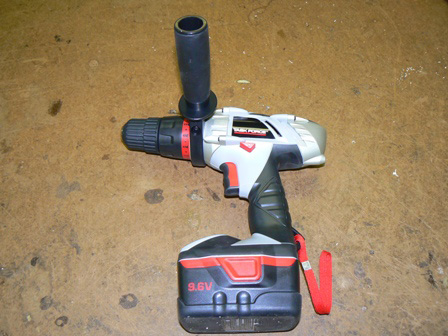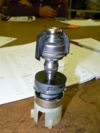Cordless drill
From DDL Wiki
Contents |
Cordless Drill
Group II
Ming Huo
Scott Miller
Vishesh Nandedkar
Mark Rockwell
Product Dissection
Before doing anything else, we dissected our drill to take a look at each part up close and understand how the drill works from a technical standpoint.
This is our entire drill, before dissection.
Parts List
Function/Purpose:
Spin "bits" with a specified torque (variable stepping torque)
- many different types of "bits"
- Drive screws
- Drill holes
- removing stripped bits
- Mixing paint/batter/dough
- pumping water w/ drill powered pump
- impromptu dremeling
- binding things
- home construction
- alignment
- safety
Inputs/Outputs:
- INPUTS: Axial force
- INPUTS: Trigger Pull
- INPUTS: Electricity (battery)
- INPUTS: Countertorque (resist what motor implements)
- OUTPUTS: Rotational motion
- OUTPUTS: torque
Use and Basic operation:
(scenario where putting screw in wall)
- Charge Battery
- Remove battery from charger
- Slide battery into drill
- Select bit/tool
- Loosen Chuck
- insert bit and tighten chuck
- select "cut-off" torque
- engage drive or gear
- Place head of screw on bit.
- Hold head of screw to bit (with hand).
- Place Tip of screw to desired object
- Partially squeeze trigger to provide low rotation-speed at first. All this while pushing axially.
- once screw's thread catch the wood, pull trigger to increase torque/omega.
- consistantly adjust to make sure bit is in line with screw.
- Let go of trigger when screw at desired location.
Different Users / Use Scenarios
- weak wrist/grip
- shaky hands
- can't push hard enough
- tightening Chuck
- Actual drilling into material
- Dead battery
- Improper/Hard surface
- Screw stripping
- Screw alignment
- Wrong bits.
- Aligning bit correctly within chuck
- Poor eyesight
- Poor hand-eye cooridnation
- Over-torquing (too soft a surface)
- Poor lighting
- no hands
- tight areas/corners (awkward shape)
- Hard time hearing maybe can't hear what's happening
- screw stripping
- overtorqueing
- not strong enought to switch between F/N/R












